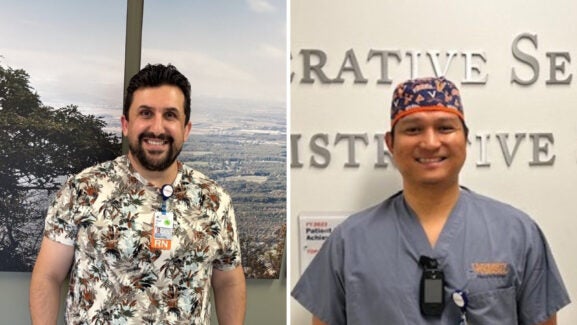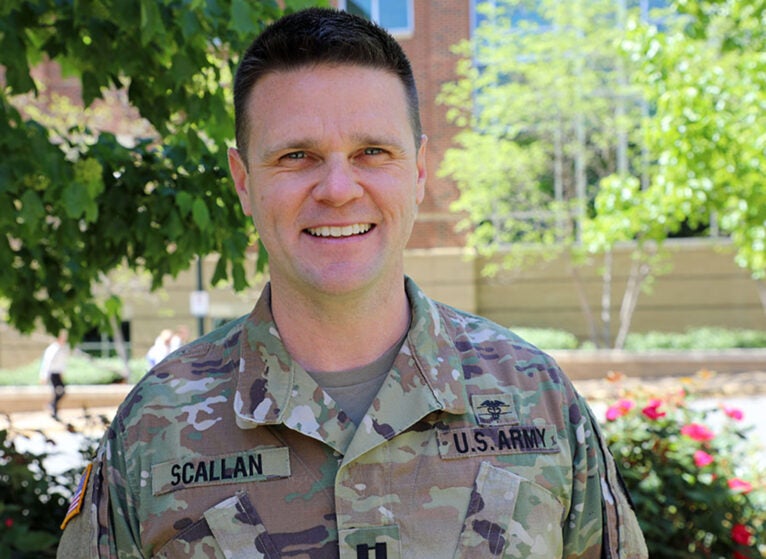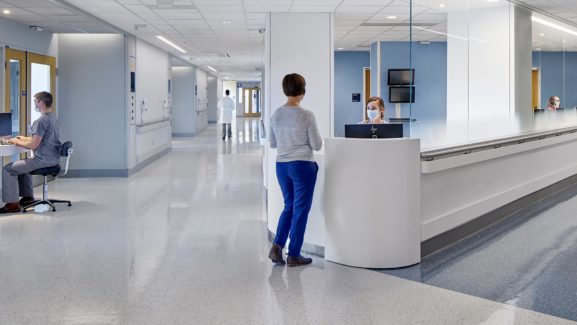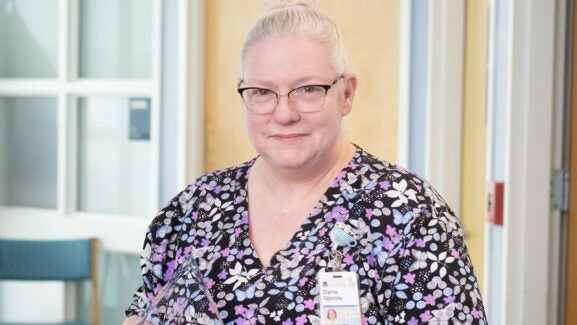

Ross Scallan is taking elements from the DNP project on workplace violence reporting he'd done during graduate school to examine whether it might be a powerful tool in a military setting.
Workplace Violence Reporting Made Easy
Pervasive, perpetual, and underreported.
That’s how DNP graduate and U.S. Army Captain Ross Scallan (MSN ’23, DNP ’24) describes workplace violence in healthcare upon exploring the literature. Roughly two nurses are assaulted every hour in the U.S., most often in emergency departments and psychiatric units. During the pandemic, nearly half of nurses — 44% — reported physical violence from patients while more than two-thirds — 68% — reported verbal abuse from patients, visitors, or family members. A 2023 study found that four in every five nurses experienced at least one violent incident during 2023.
When nurses experience violence, Scallan explained, it can have a destructive and compounding impact on their physical, psychological, and professional health, possibly degrade the quality of their care and impose financial burdens on hospitals due to absenteeism and potential legal fees. At the moment, few health systems effectively deal with workplace violence, and few reporting structures exist to capture its true frequency and impact. Studies show that just 7 to 30% of nurses ever formally report violence at the workplace, many times because of the misguided perception that “taking it” is just part of the job.
Says Scallan — who, for his final scholarly DNP project, developed, deployed, and tested an easy-to-use instrument that resulted in a 1,080% increase in healthcare staffers’ reports of workplace violence — "Nurses didn’t sign up to be cussed at, spit at, assaulted, or even sexually assaulted when we became nurses. It isn’t and should never be part of the job.”
What’s your role?
I work as a clinical nurse specialist (CNS), alongside my fellow military nurse scientists. As CNSs, we provide direct patient care, clinical consultation for our nurses, and help the hospital’s senior leaders address problems that need fixing using evidence-based practice. We specialize in implementation science, look into the literature and research to explore best practice, and then roll out changes within clinical practice.
It’s a great job, because we can insert ourselves when we observe or discover clinical gaps and problems that need our attention, whether it’s on a unit, or if it’s part of a broader organizational problem. One aspect of my work is looking for ways to strengthen our healthcare teams at the unit and organizational level to create more resilient environments for our patients and staff.
Talk about why you chose to study a reporting instrument for workplace violence, and what you did.
A lot of people say, “I had no idea workplace violence was such a problem.” Statistics will tell you, though, that most healthcare professionals will be assaulted or yelled at over the course of their careers. In the civilian emergency department (ED) where I implemented my project, there was a clinical need, a gap, an opportunity for improvement by developing an instrument to streamline reporting workplace violence.
I began my work by observing and assessing the ED’s clinical environment, letting that needs assessment and clinician survey dictate unit needs. The literature and evidence would later guide me as I developed my project and intervention.
We knew we needed to have a good, accessible, easy-to-use reporting system in place to have a valid, accurate way to document the frequency of violent events — when, where, why they were happening. Once you have all that data, it can inform leaders of those units and departments so they can set up risk mitigation measures and provide support to affected clinical staff.
Why do clinicians hold back from reporting violence they see or experience?
What’s cited in publications and research repeatedly is that nurses believe it’s “part of the job” — that it comes with the territory. But that’s a narrative we must change, because dealing with abuse and violence on nurses is not in our job descriptions, and nurses didn’t sign up to be verbally accosted or cussed at, spit on, or assaulted as part of our job.
What did you find?
After a needs assessment, a literature review, project planning of interventions, and development of a simple, one- to two-minute Qualtrics survey instrument that was accessible through a QR code, we had 59 complete reports from 94 scans of the instrument over the two-month study period, a 1080% increase in reporting compared to the previous two months before the instrument was in use.
Our data showed that roughly half of the reports we got were anonymous, that more than three-quarters came from nurses, and that violent events were most frequent from 12-6 p.m. and took place most often in treatment rooms (37%), waiting rooms (19%), the behavioral health section (15%), and in the hallway (12%).
Addressing workplace violence doesn’t end when you create an instrument, though. You also have to influence the culture of safety to say, “Leadership knows this is a problem. The chief nurse and chief physician know it’s a problem, and we’re here to support you.” It helps people feel safe when reporting. There is evidence that some clinicians feel that, even when they report violence, nothing happens. It gets swept under the rug, isn’t taken seriously, and might result in peer bullying. Staff, physicians, nurses, and techs aren’t going to feel the benefit of that safety net and they’re not going to feel comfortable reporting and simply won’t report if they do not feel the support from leaders and that each report matters.
You’ve got to create a culture of safety and awareness to underscore the importance of reporting while also building a good, easy-to-use instrument. If you do those things, you’ll get higher participation and buy in for your efforts.
What were your big takeaways from the project?
While we often talk about how nurses are most affected, the big takeaway is that workplace violence affects multiple groups, and not just the person who receives it: the person who greets patients at the door, a hospital volunteer, someone in an administrative role at a desk, checking people in. Everyone sees it, however most don’t know what to report and how to report it.
Let me provide an example .... Say there’s an event in a patient’s room: everyone looks at one another and says, “Who’s going to report that?” Whether a workplace violence is an explosive event, involving numerous people and several injuries, or it’s a more localized event in which someone yells at one nurse; many people are exposed, and, thus, affected. By definition, we all need to report it if we are exposed to it, which typically doesn’t happen. If we could increase reporting numbers, then we’d have a better idea of the true number of people being exposed.
You’re not just reporting for you; you’re reporting for all the other nurses and healthcare professionals as well. We have a duty to report to ourselves and others, and organizations such as OSHA and the Joint Commission provide guidance on what and how we need to report. When it takes too long, or people don’t want to do it, what I tell nurses is whether it’s something benign or egregious, all of those things matter and should be reported.
Can you deploy the same reporting instrument your team developed in a military health setting?
While this instrument and evidence-based change could be tailored to the military healthcare setting, it's important to understand that this DNP project and reporting instrument were originally designed for use in a civilian healthcare ED. There are many aspects from this project that could be adapted and applied in the military healthcare setting, but all of them would first need to start with a gap analysis and needs assessment survey, as I did in my DNP project. This allows the ability to understand the current clinical environment and problems and adapt interventions specific to the needs.
The military health system is a unique healthcare environment in many ways. Unlike civilian hospitals, military medical treatment facilities serve a dual mission: we ensure our service members are medically ready to defend our nation at a moment’s notice, while also providing ready, reliable care to military families, retirees, and occasionally even international allies. This dynamic and mission-driven healthcare setting is unique from civilian health systems in that way.
Our military hospitals are great places to receive quality and safe patient care. However, we owe it to our staff and patients to explore every opportunity to continuously improve. As an Army nurse and officer, I am committed not only to caring for patients, but also to supporting the well-being of the nurses, medics, and other healthcare professionals I work alongside with every day. And part of that includes fostering a healthy workplace and safety culture; asking questions about healthcare problems and challenges, like how we define and understand stressors in the workplace.
What motivated you to turn your attention to addressing workplace violence in the military? What will you do?
The spark for this work came from my DNP project, where I explored how civilian ED nurses experienced and reported workplace violence. My findings inspired me to evaluate how this applies to military medicine. While our military hospitals are professional, safe places to work and receive care, we also recognize the importance of leadership-driven efforts to examine and improve every aspect of how we deliver healthcare.
In collaboration with other military medical centers enterprise-wide, I’m now contributing to a broader initiative to develop a military health system-wide assessment of workplace violence. The goal is to better understand the prevalence, what it looks like in military settings, both at home and in austere, deployed environments, and how we can take steps to prevent and mitigate. This work is still in its early stages, and we’re approaching it with a commitment to accuracy, respect for the unique military culture, and a desire to ensure all staff and patients continue to feel supported and safe.
A significant portion of our nursing workforce includes both military and civilian personnel, so we’re designing our survey to reflect that reality. We're starting with data, gathering insight into where, when, and how incidents may occur, so we’ll be able to offer recommendations that are data-driven and tailored to the unique structure of military medicine. Ultimately, with the goal to improve upon workplace environments for both our patients and the healthcare teams who serve them.
Your scholarship was published in the Journal of Emergency Nursing. That must’ve been edifying. And fun!
It is. It’s a lot of work, but also so rewarding! I often tell my wife that I love what I do, however exhausting it sometimes is, because what we do is so impactful to patients, nurses, and military leaders ... not negative connotation exhausting but making a difference exhausting.
There is a lot of purpose and hard work in what we do as a CNSs, and it really matters, whether it’s conversations that influence and shape organizational change or something broader, like in a classroom setting, it has relevance, meaning, and impact!
Latest News



